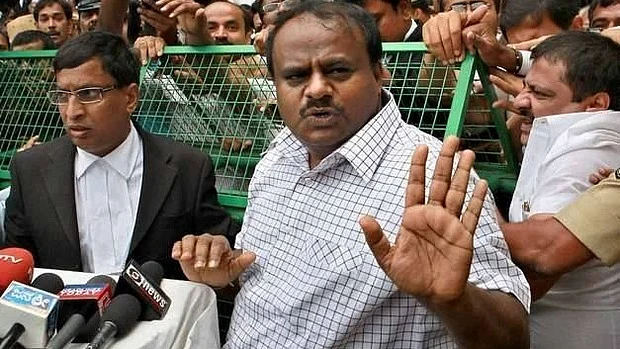Hours after BJP won the Gujarat Assembly elections, chants of “Ab ki baar Karnataka (it’s time for Karnataka)” rent the air at the party headquarters in Ahmedabad. At the same time, the Congress in Karnataka dubbed the BJP’s loss in seat share in their leader’s home state as a moral boost for it ahead of three crucial Assembly elections, including Karnataka, due sometime in April 2018.
In short, the post-Gujarat politics in Karnataka has been so far limited to a contest between Congress and BJP. However, unlike Gujarat, Karnataka has a strong, third political party. Janata Dal (Secular) is hopeful of becoming the kingmaker in Karnataka in the upcoming election.
Pre-Poll Survey Predicts Lack of Clear Majority
A pre-poll survey conducted by Suvarna News claimed that neither the Congress nor the BJP will get a clear majority. Of the 224 seats, the pre-poll prediction gave 88 to Congress, 82 to BJP, 43 to JD(S) and 11 to others.
As per the numbers, JD(S) will get close to 20 percent of the vote share. With neither party getting majority, a coalition government could be a possible outcome, gifting JD(S) the bargaining power.
New Political Equations
Why is a coalition government a strong possibility? The answer is in the change of structure of the leading political parties. The internal differences in the BJP had played a huge role in the Congress getting a majority in 2013 — Yeddyurappa, the most senior leader in Karnataka BJP, had split from the party to form a new outfit, Karnataka Janata Dal (KJP), dividing the BJP’s vote bank.
As the large Lingayat and Vokkaliga vote banks were split between BJP and KJP, Congress’s Siddaramaiah gained a majority with votes from Dalits, backward classes and other minorities.
But in 2017, Yeddyurappa is back with the BJP and the party’s vote bank seems consolidated once again. In the new powerplay, the chance of any party getting a clear majority is considered unlikely.
Not A Reliable Ally
Even though a coalition government is an option, both Congress and BJP would rather not have it. The reason is that both parties have had bitter experiences while running coalition governments with JD(S) in the past.
Coalition with Congress: Following the 2004 Assembly elections, BJP had emerged as the single largest party in Karnataka with 79 seats, followed by the Congress with 65 and the JD(S) which won 58 seats. Congress and JD(S) struck a deal to form a coalition government. Despite JD(S) leader HD Kumaraswamy bargaining for the chief minister’s post, he was given the deputy chief minister’s post and Congress’s Dharam Singh was made the chief minister.
After 19 months, the coalition began to crumble. Several reasons were given for the fallout, including Congress’s attempt to poach current chief minister Siddaramiah, who was then a part of JD(S); Congress not entering a coalition with JD(S) for the local body elections; and rumours that the Congress was planning to go in for a midterm election.
Coalition with BJP: After 19 months of rule, JD(S) withdrew its support for Congress and the JD(S) MLAs were flown to a resort in Goa. Within a few days, a new deal was reached between BJP and JD(S) to form a new government.
As per the deal, the chief ministership was to be shared between Kumaraswamy and BS Yeddyurappa for an equal period of time. The first chance at chief ministership was given to Kumarswamy, while Yeddyurappa served as his deputy.
As part of a power-sharing agreement, Kumaraswamy was to leave the post of chief minister on 3 October 2007. But when the time came, he refused. This forced Yeddyurappa and all the ministers from his party to resign and on 5 October, the BJP formally withdrew support to the Kumaraswamy government.
Karnataka came under President's rule, which was revoked on 7 November after JD(S) and the BJP decided to continue with the alliance and make Yeddyurappa the chief minister. Yeddyurappa was sworn in on 12 November 2007 as the Chief Minister of Karnataka, he remained in the post for 7 days, as JD(S) withdrew its support.
Will There Be Another Coalition?
In a recent interview, Kumaraswamy had claimed that he will not form a coalition government with the BJP again. While all three parties are claiming they would win a majority, in case of a hung House, it is likely that a coalition will be formed between the Congress and JD(S). The current chief minister being a former JD(S) man gives more probability to this option. However, Kumaraswamy has been training his guns against Siddaramaiah ahead of the elections.
While poll results are far away, JD(S) has begun its campaign. Apart from hoping to gain from its usual strongholds of rural Bengaluru, Mandya and Mysuru, Kumaraswamy has been appealing to the Veerashaivas and Kurubas to support his bid to become Chief Minister again.
